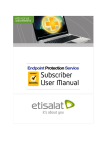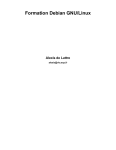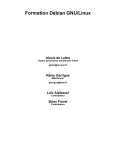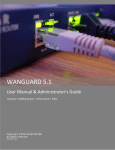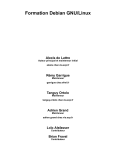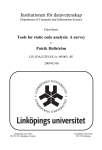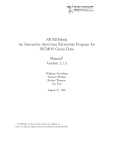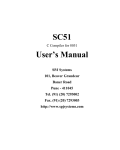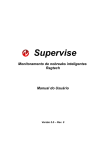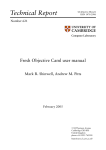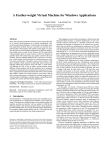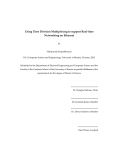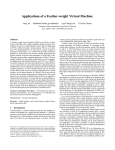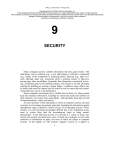Download A General Dynamic Information Flow Tracking Framework
Transcript
A General Dynamic Information Flow Tracking Framework for
Security Applications
Lap Chung Lam, Tzi-cker Chiueh
Rether Networks, Inc.
75 Health Sciences Drive suite 111
Stony Brook, NY 11790, USA
{lclam, chiueh}@rether.com
Abstract
processes, machines, and even Internet sites.
Tracking information flow within a program requires
following edges in the program’s data flow graph, and
propagating tags from the dependees to the dependents. Given an application program and its applicationspecific tag initialization and propagation rules, in theory a compiler should be able to simulate tag propagation and compute the tag values associated with program
variables through abstract interpretation and symbolic
execution. In practice, it is not feasible to statically determine the tag value of every program variable because
of pointer aliasing and loops with a dynamic bound.
Therefore, accurate information flow tracking has to be
done dynamically. This requires instrumentation of programs so as to initialize, propagate and combine tags appropriately as their corresponding program variables are
being processed. While it is possible for application programmers to take on this instrumentation task, it would
be ideal if a compiler could automate the entire program
instrumentation process and make it more efficient and
less error-prone. This paper describes the design and
implementation of such a compiler called GIFT (General dynamic Information Flow Tracking).
GIFT is a compiler for programs written in the C
language that takes programmer-specified applicationspecific rules for tag initialization, propagation and combination, and automatically instruments programs so as
to execute these rules as part of the program execution. GIFT not only significantly improves the accuracy of information flow tracking by applying dynamic
data/control flow analysis, but also largely automates
the process of implementing information flow tracking
into individual applications. To the best of our knowledge, GIFT is the first known application-independent
implementation framework for information flow tracking, which could be quickly customized through incorporation of application-specific knowledge.
Compared with static information flow tracking [10,
16], GIFT guarantees accurate information flow tracking because it follows data and control dependencies that
actually take place at run time. Compared with statistical correlation or machine learning approach to information flow tracking [17], GIFT is completely automatic
without requiring a time-consuming and labor-intensive
training process. Finally, GIFT makes it possible to in-
Many software security solutions require accurate
tracking of control/data dependencies among information objects in network applications. This paper
presents a general dynamic information flow tracking framework (called GIFT) for C programs that allows an application developer to associate applicationspecific tags with input data, instruments the application to propagate these tags to all the other data
that are control/data-dependent on them, and invokes
application-specific processing on output data according to their tag values. To use GIFT, an application developer only needs to implement input and output proxy
functions to tag input data and to perform tag-dependent
processing on output data, respectively. To demonstrate the usefulness of GIFT, we implement a complete
GIFT application called Aussum, which allows selective sandboxing of network client applications based on
whether their inputs are ”tainted” or not. For a set
of computation-intensive test applications, the measured
elapsed time overhead of GIFT is less than 35%.
1
Introduction
Information flow tracking refers to the ability to track
how the result of a program’s execution is related, via either data or control dependencies, to its inputs from the
network, the file system and any other external parameters such as environment variables and command line
arguments. To accurately track information flow, each
piece of input should be assigned a tag, which could be
a bit (e.g. taint bit) or a pointer to an arbitrarily complex meta-data structure, and for each assignment operation, the tag of the assignment operation’s left-hand
side is derived from the tags at its right-hand side according to certain tag combination rules. Different information flow tracking applications require different types of
tag and use different tag combination rules. Moreover,
to accommodate modern network services that consist
of multiple programs communicating with each other
through messages, it is essential to track information
flow not only within a single process, but also across
1
the outside world, i.e., a file system, a remote node,
or another process. Output channels are intercepted
and redirected in the same way as input channels to
their proxy functions, which typically examine tags
for the data to be output and make certain decisions.
For example, a user can intercept write system
calls using a proxy function write proxy(int
fd, void *buf, int side), which can examine the tag associated with the variable pointed
by buf and decide to reject a write call that tries
to write a password file to a socket descriptor.
strument the same program differently when it is used
in different applications or systems, in a way tailored
to their security requirement. Therefore, GIFT allows
clean decoupling of application logic from tag manipulation logic. In summary, GIFT is an enabling technology that could be immediately applied to a wide variety
of information flow accounting applications, including
information flow control, intrusion impact assessment,
execution trajectory analysis, etc.
To demonstrate the usefulness of the GIFT framework, we build a tool based on GIFT called Aussum,
which could automatically instrument arbitrary network
applications to track the provenance of information objects and enable selective sandboxing on the execution
of application programs when they operate on information objects from suspicious sources. Aussum solves
a long standing problem for existing behavior blocking
or sandboxing systems [1]: How to minimize disruption to legitimate applications while stopping all malicious attacks? By leveraging GIFT’s accurate information flow tracking, Aussum allows the same application
to be sandboxed in a different way when it operates on
different input objects.
2
• Assignment Statement: After every assignment
statement in a program, the GIFT compiler inserts
a call to a programmer-provided function (by default its name is gift set tag) to combine the
tags associated with program variables at the righthand side to form the tag associated with the variable at the left-hand side. The proxy function takes
the addresses of the tags of all variables in the assignment statement as the arguments, and performs
application-specific tag value propagation from the
right-hand side to the left-hand side.
In addition, GIFT provides the following library
functions for the programmer-provided functions to access the tags of a function call’s arguments:
General Dynamic Information-Flow
Tracking Framework (GIFT)
• void * gift lookup tag(void *address).
If the input parameter is a pointer to a memory block,
this function looks up the address of the tag associated
with the memory block pointed by address.
• void * gift lookup parameter tag(int
index). If the input parameter is not an pointer, this
function returns the address of the tag associated with
the index-th argument.
• void gift save return tag(void
If a proxy
*return address, void *tag).
function needs to return a data value, this function is
called to save a copy of its tag into the shadow stack.
GIFT associates each program variable in an application with a 4-byte tag, which could correspond to a
piece of metadata that annotates the variable or a pointer
to another data structure that annotates the variable. Being an application-independent information flow tracking framework, the GIFT compiler does not interpret
the tags, and leaves their interpretation to the application programmers. Therefore a tag can be used to represent different metadata for different types of information flow tracking, for example, packet ID, user ID,
file name, network IP address, security class, etc. The
main job of the GIFT compiler is to insert code that
calls programmer-provided tag initialization and combining functions at the times specified by the programmers. The GIFT compiler is also responsible for passing
tags throughout an entire program.
To use the GIFT compiler, the application programmer needs to specify a set of interception points, each of
which corresponds to a function in the original application, and a proxy function that should be called instead
at each of the interception points. Currently, GIFT supports the following three types of interception points:
GIFT is derived from GCC 3.3.3. To add dynamic information flow tracking to an applicationi
using GIFT, the user needs to implement proxy functions for input/output channels and gift set tag
for assignment statements in a object file and link
the original program with the object file.
For
example, if a developer wants to compile a file
called myprogram.c, she should invoke GCC using
“gcc -fgift -fgproxy=myproxy.pro
myprogram.c myproxy.o”. The -fgift option
enables GIFT’s instrumentation. The names of the
intercepted functions and their corresponding proxy
functions are specified in the file called myproxy.pro.
The file myproxy.o contains the developer-provided
proxy functions and the tag propagation function for
assignment statements.
• Input Channel: These correspond to functions
that bring external data into an application’s address space, such as read() or write() functions for the file system, the network, and share
memory regions. When these functions are called,
the GIFT compiler redirects the calls to their corresponding proxy functions, which perform tag initialization for those program variables that are allocated to receive external inputs.
3
3.1
• Output Channel: These correspond to functions
that move data in an application’s address space to
Design and Implementation of the GIFT
Framework
Tag Management
GIFT associates a tag with each data memory block,
which could be a local variable, a global variable, or a
2
1
1 int buffer[10];
2
2
3
3 void work(void)
4
4 {
5
5
int a, b, c, d;
6
6
b = 10;
7
c = 20;
7
8
read(socket_fd, &a, 4);
8
9
d = decode(&a, b, c);
9
10
10
write(output_fd, &d, 4)
11
11 }
12
12
13 int decode(int *a,int b,int c) 13
14
14 {
15
15
int r;
16
16
r = *a+b+30;
17
return r;
17
18 }
18
19
20
21
22
23
24
25
26
27
28
29
30
31
32
33
34
35
36
37
38
39
40
int buffer[10];
void work()
{
int a, b, c, d;
int a_tag_info=0, b_tag_info=0, c_tag_info=0, d_tag_info=0;
int fun_index;
fun_index = gift_add_locals_to_tree(2,
&a, 4, &a_tag_info, &d, 4, &d_tag_info);
b = 10;
b_tag_info = 0;
c = 20;
c_tag_info = 0;
gift_save_argument_tag(aussum_read, 1, &socket_fd_tag_info)
read_proxy(socket_fd, &a, 4);
gift_save_argument_tag(decode,2,&b_tag_info,1,&c_tag_info,2);
d = decode(&a, b, c);
gift_copy_return_tag(decode_return_address, &d_tag_info, 0);
gift_save_argument_tag(aussum_write, 1, &output_fd_tag_info)
write_proxy(output_fd, &d, 4)
gift_remove_locals_from_tree(fun_index);
}
int decode(int *a, int b, int c)
{
int r;
int r_tag_info=0, b_tag_info, c_tag_info;
gift_init_parameter_tag(decode,2,&b_tag_info,1,&c_tag_info,2);
r = *a+b+30;
gift_set_tag(&r_tag_info, 0, 2,
a, 1, &b_tag_info, 0);
gift_save_return_tag(return_address, &r_tag_info);
return r;
}
__GLOBAL_FileName()
{
gift_add_globals_to_tree(1, buffer, 40);
}
(A) Original
(B) Transformed
Figure 1. This code segment illustrates how GIFT optimizes away splay tree look-ups by directly accessing a
memory block’s tag, which is stored in a shadow variable, if it is accessed through its name. The statements in
the bold font are inserted by GIFT.
memory area returned by a malloc() call. Because a
data memory block can be accessed through pointers, it
is necessary to provide a mechanism to identify a memory block’s tag from a pointer to the memory block. The
explicit look-up approach [6], uses a separate search data
structure to associate a pointer with its metadata, and
completely does away with modification to pointer representation. For each data memory block, this scheme
creates a node in a splay tree, which stores the base address and the size of the memory block, and the memory block’s metadata. Given a pointer, this scheme first
looks it up in the splay tree to identify the corresponding
metadata. A pointer matches a splay tree node if it falls
within the node’s extent as defined by its base and size.
Originally we implemented GIFT using the splay
tree scheme, where each tree node contains the base,
extent, and tag of a data memory block. However, we found that the splay tree scheme incurs a serious performance penalty for computation-intensive applications due to tree lookups. To reduce this performance penalty, we use a shadow variable to store the tag
of every global/local memory block instead of putting
the tags into the splay tree. The key idea is that if a
memory block is accessed through its name, the GIFT
compiler directly looks up its tag in its shadow variable
without looking up the splay tree. However, if a memory
block is accessed through a pointer, GIFT creates a splay
tree node for it, which contains a pointer called int
*tag ptr that points to the shadow variable holding
the memory block’s tag. When a memory block is accessed through a pointer, GIFT looks up the splay tree
to locate its corresponding shadow variable. If a memory block is returned by malloc, GIFT stores its tag in
the int tag field of its corresponding splay tree node;
in this case the tag ptr pointer of its splay tree node
points to its int tag field.
Figure 1 illustrates GIFT’s instrumentation using a
simple program and its transformed version. All variables whose name ends with a tag info suffix in Figure 1(B) are shadow variables inserted by the GIFT compiler. Line 12 and 14 in Figure 1(B) show that the tags
of b and c, i.e. b tag info and c tag info, are directly accessed because these two variables are accessed
through names. In addition, the GIFT compiler inserts
the following functions into a program to manage tags:
• int gift add locals to tree(int number, [void *address, int
size, void *tag addr]). This function is inserted in each
function’s prologue to create splay tree nodes for all local data variables and input parameters, whose addresses
are assigned to pointers, as illustrated by the call at Line
8 of Figure 1(B). This function takes a variable number of arguments. The first argument number indicates how many triples of [void *address, int
size, void *tag addr] are passed to the function, where address is the base address of a data
variable, size is the size of the data variable, and
tag addr is the address of the associated shadow variable. The return value of this function is used to remove
the tree nodes when the function returns.
• void gift remove locals from tree(int fun index). This
function is inserted in each function’s epilogue to remove
all tree nodes allocated for the current function. The parameter fun index is the transaction ID returned by
gift add locals to tree.
3
• void gift add globals to tree (int number, [void *address, int size, void *tag addr]). This function is used
to allocate tree nodes for all global and static data variables in a source file. Its prototype is similar to that of
gift add locals to tree except that it does not
need to return a transaction ID because it is not necessary
to explicitly free the tree nodes allocated to the global and
static data variables. GIFT creates a global constructor
function for each source file as indicated by the function
at Line 37 of Figure 1(B). The compiler always generates
code to call global constructor functions before the main
function is executed.
If a function returns a non-pointer value back to the
caller, GIFT also needs to propagate the tag of the return value to the caller. It uses the same shadow stack
mechanism as in the case of a function call. But the
arguments pushed to the shadow stack are the return address and the address of the return value’s tag, as shown
by the call to gift save return tag at Line 33
of Figure 1(B). The first argument return address
is the return address of the callee, which is generated
by the GIFT compiler. The caller compares the return address on the shadow stack with the call site,
and propagates the tag of the return value accordingly
if they match by calling gift copy return tag,
as shown in Line 19 of Figure 1(B). The first argument decode return address of the call to
gift copy return tag is the call site/return address of the call to the function decode at Line 18.
Gift copy return tag compares this return address with the return address stored in the shadow stack.
If the two return addresses do not mach, the function
call is returned from a legacy function, which does not
place the return tag on the shadow stack. In this scenario, gift copy return tag treats the return tag
as zero.
When a GIFT function calls a legacy function, the
tags that the GIFT function puts on the call shadow stack
is ignored. When the GIFT function returns, the information that the GIFT function puts on the return shadow
stack is ignored by the legacy function. In either case,
the program continues working without any disruption.
Consequently, the above tag propagation scheme solves
the compatibility problem associated with the shadow
variable approach.
To avoid complete re-compilation of the LIBC library, GIFT includes a set of wrapper functions for
memory and string copying library functions in LIBC,
such as memcpy and strcpy. The GIFT compiler
redirects all calls to memory/string copying functions to
their corresponding wrapper functions, which properly
set the tag of the destination memory block using the
tags associated with the source memory blocks.
• void gift add heap to tree(void address, int size) is
called in the malloc proxy functions to create tree
nodes for heap memory blocks allocated by malloc.
• void gift remove heap from tree(void *address) is called
in the free proxy function to remove tree nodes associated with heap memory blocks.
3.2
Dynamic Tag Tracking
For each assignment statement in the program, GIFT
inserts a call to gift set tag, which sets the tag
of the left-hand-side memory block based on those of
the right-hand-side blocks, as shown in Line 31 of Figure 1(B), which corresponds to the assignment statement in Line 16 of Figure 1(A). In this case, the
address of r’s shadow variable, the address of the
memory block pointed to by a, and the address of
b’s shadow variable are passed to gift set tag,
which only needs to look up the splay tree for the
address of a’s shadow variable. Because GIFT does
not understand how a tag is used, after the addresses
of all the shadow variables involved in an assignment statement are resolved, gift set tag calls
the user-supplied function gift do set tag(void
*ltag, int number, void *tags) to actually
propagate the tags. The argument “void *tags” of
this function are the addresses of the shadow variables
of the right-hand-side memory blocks.
When an input argument of a function call is not
a pointer, GIFT needs to propagate its tag to the
callee. Instead of passing the tag through the standard stack, which could cause compatibility problems with legacy code, GIFT allocates a shadow
stack, one per thread, to pass the tags of nonpointer function call arguments.
Specifically, the
caller calls gift save argument tag, e.g., Line
17 of Figure 1(B), to place on the shadow stack
the entry point of the callee and the tags of nonpointer arguments before the call. The callee calls
gift init parameter tag to retrieve the tag for
each parameter. Gift init parameter tag first
compares the callee’s entry point with the entry point
stored on the shadow stack. If they match, the tags of
the parameters of the callee are initialized with the tag
values passed through the shadow stack. If two entry
points do not match, this indicates that callee is called
from a legacy function, which does not push the tags of
the actual arguments to the shadow stack. In this case,
gift init parameter tag initializes each parameter tag with zero.
3.3
Array, Union, and Structure
GIFT treats each array, union, and structure variable
as a single memory block, and allocates to it a single
tag. This means that the tag of an array/union/structure
should contain the most important metadata associated
with that variable. If fine-grained tagging, for example
one tag for each field in a structure variable, is needed,
the developer can use the structure variable’s shadow
variable as a pointer to a more complex tag data structure, which can contain many sub-tags.
3.4
Slicing Optimization
Blindly intercepting all assignment statements and
function calls/returns in a program may result in many
unnecessary calls to GIFT library functions when only
parts of the program involve data read from input channels. To focus only on those program statements that
4
manipulate data related to input channels, GIFT uses
the program slicing result from a commercial tool called
Codesurfer [5]. Given a set of input and output functions
that users want to intercept, GIFT computes a forward
slice of the original program from the input functions
and a backward slice from the output functions, and
takes the intersection between the two slices. The resulting program segment is a set of statements that GIFT
instruments because they are affected by input data and
their results may be used by output functions.
While conceptually promising, the performance gain
from this optimization depends on the pointer usage in
the applications. If an application uses pointers and/or
function pointers extensively, this slicing optimization
does not help much, as Codesurfer’s pointer analysis is
not very effective. Even when Codesurfer just performs
flow-insensitive pointer analysis, it requires an inordinate amount of memory resource and could run very
slowly when one turns on the most accurate pointer analysis option. In the case of less accurate pointer analysis
option, the result that Codesurfer produces is not much
different from the original program, and as a result slicing does not result in any noticeable performance improvement.
therefore cannot protect end user machines from zeroday attacks. Behavior blocking or sandboxing [1],
which monitors and restricts network applications’ execution according to a pre-defined security policy, is
considered a better alternative against zero-day attacks,
because it focuses on benign program behaviors rather
than malicious ones. However, in practice, the behavior
blocking technology exhibits two pitfalls. First, behavior blocking could disrupt the operation of legitimate applications because, for safety, the sandboxing policy is
typically set stricter than necessary. One way to solve
this problem is to apply program analysis techniques
to extract highly accurate sandboxing policies directly
from application programs’ source or binary code [7].
Second, existing behavior blocking systems do not
support selective sandboxing, which sandboxes the same
application differently depending on the mode in which
the application is currently in. To solve this problem,
some existing sandboxing systems such as Tiny Firewall [18] require the end user to specify both the applications that need to be sandboxed as well as the policies to
be used. This approach is inconvenient and error-prone.
Eventually the user is likely to choose convenience over
security and turns off sandboxing completely. Other
systems such as SEES [8] attempt to address this problem by transparently intercepting the file download path
of web browsers and email clients, and marking each
downloaded file. These systems then sandbox the execution of a program if it itself is marked or the object it
operates on is marked (such as Mcrosoft WORD). However, this approach is limited because the way they mark
downloaded files is very specific to individual applications and therefore cannot be generalized to arbitrary
network applications.
This section presents the design and implementation
of Aussum, which is an application of the GIFT compiler framework that can automatically instrument network applications so as to enable selective sandboxing. Aussum leverages GIFT’s dynamic information
flow tracking capability to automatically mark contents
downloaded from the Internet. When marked contents
are written to a file, Aussum marks the file in such
a way that any subsequent execution using that file is
sandboxed. In addition, If a network application uses
marked contents as input arguments to sensitive system
calls such as exec, open, and unlink, these system
call invocations are also sandboxed. Because of the finegained information flow tracking capability, Aussum allows a legitimate application such as Microsoft’s IE or
WORD to run with full privilege when it operates on local files, but is properly sandboxed when it operates on
objects downloaded from the network. Moreover, Aussum injects this selective sandboxing capability to network applications in a way that is completely transparent to the applications’ developers and users.
Figure 2 shows the system architecture of Aussum,
which adds three modules into a network application.
The Input Monitor marks as tainted input packets from
network connections that are considered suspicious according to a security policy stored in the Security Policy Hooks module. The Dynamic Taint Tracker propagates the taint attribute of data items across a program’s
Aussum Subsystem
Application Binary
aussum_proxy.o
Original Code
Application
Source Code
GIFT
Compiler
Inserted Code
aussum.proxy
Input
Monitor
network connections
Dynamic Taint
Tracker
System Call
Monitor
Security Policy Hooks
User−Level
Security Policy
Callback Function
Library
User
Sandbox Subsystem
Kernel
Linux Kernel
Figure 2. The Aussum compiler is built from
the GIFT framework. The Input Monitor intercepts data read from a network connection and
marks it according to a configurable security policy. The Dynamic Taint Tracker propagates the
mark throughout the program. Finally the System Call Monitor marks files and system call arguments that are derived from network inputs.
4
4.1
Selective Application Sandboxing Using
GIFT
Overview
Many end user computers are infected by malicious
programs because the users knowingly or unknowingly
download from the network objects containing malicious programs, by reading email attachments, file transfer, web browsing, and peer-to-peer file sharing. Most
existing anti-malware tools are based on signatures and
5
computation. The System Call Monitor checks the arguments of sensitive system calls such as unlink, open,
and exec, and invokes the operating system’s sandboxing mechanism when their arguments are tainted. In addition, when tainted data is written to a file, the System
Call Monitor marks the file as tainted according to the
same security policy. The security policy in the Security Policy Hooks module is represented in the form of
callback functions, which determine if a network connection should be considered suspicious and/or if a file
should be marked as tainted. When a tainted file is executed or used as input to a new process, Aussum automatically sandboxes the corresponding process. Aussum can work with any existing sandbox system as long
as the sandbox system implements the security policy
hook functions required by Aussum.
1
2
3
4
5
6
7
8
9
10
11
12
13
14
15
16
17
18
19
20
21
22
23
back function int mark connection(sockaddr
*addr), is null, the underlying sandboxing system
does not have any specific security policy, and Aussum
simply marks every network connection descriptor as
tainted. The parameter addr gives the sandboxing system an opportunity to examine the remote IP address to
decide if the connection should be marked tainted.
In Aussum, a tag’s value is either 0 or 1, where 1
means tainted and 0 means not tainted. To initialize the
tag for data read from a descriptor, the Input Monitor
intercepts such system calls and LIBC function calls as
read, fread, fgets, recv, and recvfrom using
proxy functions, each of which first calls the original
function, and then checks if the socket/file descriptor is
marked as tainted by looking up the descriptor table. If
data is read from a tainted descriptor, Aussum locates
the corresponding node in the splay tree, and sets its tag
to 1; otherwise the tag is set to 0.
Struct au_descriptor_t{
int suspicious; /* tag to identify network descriptor */
int type;
/* file or socket */
char *name;
/* ip or file name */
} *au_descriptor[max_open_files];
4.3
int aussum_connect(int s, struct sockaddr *addr, socklen_t *addrlen)
{
int ret;
ret = connect(s, addr, addrlen); /* call the original function */
if(ret != −1){
/* connection successes */
. . .
/* create descriptor entry and set the ip
/* callback function implemented by the sandboxing system*/
if(mark_connection_ptr != NULL){
if(mark_connection_ptr(addr)) /*let a sandboxing system to ma
au_descriptor[s]−>suspicious = TRUE;
else
au_descriptor[s]−>suspicious = FALSE;
}
else
au_descriptr[s]−>suspicious = TRUE; /* default operation */
}
return ret;
}
GIFT requires developers to implement their own
gift do set tag to propagate tag values across assignment statements. In Aussum, the tag of the lefthand-side memory block of an assignment statement is
the bitwise OR of the tags of the memory blocks at
its right-hand side. That is, if any memory block on
the right-hand side is tainted, the left-hand-side memory block is also tainted. The following code shows the
Aussum’s implementation of gift do set tag:
Figure 3. Proxy Function for connect.
4.2
Dynamic Taint Tracker
void gift_do_set_tag(void *lhs_tag, int num,
void *rhs_tags)
{
int i, tmp = 0;
int **rt = (int **)rhs_tags;
for(i = 0; i < num; i++)
tmp = tmp|(*rt[i]);
*(int *)lhs_tag = tmp;
}
Input Monitor
Because both network connections and files are
accessed through descriptors using functions such as
read and fread, the Input Monitor needs to first
identify tainted descriptors so that it could properly
mark results of read and fread calls as tainted.
In each application, Aussum maintains a descriptor
table to store information about each opened file or
socket descriptor. To mark a descriptor, Aussum uses
GIFT to redirect each call to accept, connect,
dup, or dup2 to its corresponding proxy function,
which creates a descriptor table entry for each new descriptor and marks it according to the security policy.
More specifically, if a security policy callback function
int mark connection(sockaddr *addr) exists, these proxy functions call this function to determine
how to mark a new descriptor; otherwise, they simply
mark all socked descriptors as tainted. For example, the
proxy function for connect works as in figure 3.
Line 10 of the proxy function in figure 3 calls
the original connect function, and Line 13-17 consults with the underlying sandboxing system to determine if a network connection is suspicious. Through
this callback function mechanism, the underlying sandboxing system can implement its own security policy.
For example, all data from a local network may be considered as safe. If the variable
mark connection ptr, which points to the call-
4.4
System Call Monitor
The System Call Monitor marks as tainted output
files that contain tainted data. If an executable file is
tainted, the sandboxing system will sandbox its execution when it is invoked. If a document is tainted,
the sandboxing system will sandbox the application that
opens it. This mechanism can effectively thwart MS
WORD VB Macro virus attacks and recent Windows
WMF attacks. Ideally the taint attribute of a file should
be an inherent part of the file so that when it is copied
to a new file, its taint attribute is copied automatically.
Under an UNIX-like operating system, there is no unused file attribute that can be used for this purpose. One
possible way to solve this problem is to create a group
called TAINTED. If a file is considered tainted, its group
owner attribute is set to TAINTED. However, Aussum
leaves this decision to the underlying sandboxing system. That is, Aussum provides a callback function for
the underlying sandboxing system to specify how files
should be marked as tainted. To support file marking,
Aussum intercepts file output functions such as write
6
4.5
and fwrite using proxy functions. For example, the
proxy function for fwrite is shown in figure 4.
1 size_t aussum_fwrite(const void *ptr, size_t size, size_t nitems, FILE *str
2 {
3
int ret;
4
int fd;
5
6
ret = fwrite(ptr, size, nitems, stream);/*call the original function*/
7
if(ret == nitems){
8
if(aussum_mark_file_ptr != NULL){ /* hook function for marking files*/
9
fd = fileno(stream);
10
if(!au_descriptor[fd]−>marked){ /* we have not marked the file */
11
if(is_suspicious(ptr))
/* is the memory location suspicous? */
12
asussum_mark_file_ptr(fd, au_descriptor[fd]−>name);
13
au_descriptor[fd]−>Marked = 1;
14
}
15
}
16
}
17
return ret;
18 }
Callback Functions as Security Policy
Aussum’s Security Policy module provides the following three callback functions for the underlying sandboxing system to determine when to treat a network
connection suspicious, when to mark a file tainted, and
when to reject a sensitive system call invocation when it
uses tainted arguments:
int aussum_mark_connection(sockaddr *addr);
/*if this function returns true, the connection to
addr should be marked as suspicious.*/
int aussum_mark_file(int descriptor, char *file_name);
/*this function marks the output file as tainted.*/
Figure 4. Proxy Function for fwrite.
int aussum_check_argument(char *function_name,
char *argument);
/*if the return value is 0, terminate the application.
if the return value is 1, simply return without
makeing the system call.
if the return value is 2, make the system call.*/
Line 8 of figure 4 checks if the underlying sandboxing system provides a file marking function. Through
the function pointer aussum mark file ptr, the
underlying sandboxing system can make its own decision on whether a file should be marked as tainted and
if so how. For example, even if data written to a file
are marked as tainted, the underlying sandboxing system can choose to mark the resulting file as not tainted
because the file type is .txt.
The embedded scripts present a technical challenge
to Aussum because it cannot afford to sandbox at all
time the application that downloads them, such as IE or
Firefox. Ideally, one should sandbox the downloading
application only when it is executing embedded scripts,
but leave it alone to run at full privilege when it operates on local files. Aussum solves this problem by selectively turning on and off sandboxing for a network application based on whether the operands it is currently
operating on is tainted or not. It makes the following
three assumptions. First, a malicious script cannot cause
damage if it cannot make system calls. Second, a malicious script can only make system calls through the interpreter that interprets it. Finally, if a malicious script
causes damage through system calls, some of the system
call arguments must be tainted. Based on these assumptions, Aussum intercepts sensitive system calls such as
open and exec to check if any of the input arguments
is tainted. By default, Aussum terminates any applications that attempt to invoke a sensitive system call using
tainted arguments, except those that use file names read
from the network to open or create non-existing files.
Aussum allows applications to open the non-existing
files because applications such as Firefox and IE need
to save to cache or temp directory files whose names are
derived from an html document file. Although this default policy may open doors to deny of service attack,
at least it prevents malicious scripts from modifying or
deleting the existing files. This policy is also consistent
with the taint data policy used in Perl.
Unfortunately, this policy may break certain peer-topeer applications, which allow a remote application to
request a local application to perform sensitive system
calls. To address this issue, Aussum again provides a
callback function called aussum check argument
to allow the underlying sandboxing system to override
the default policy by allowing, for example, read and
write accesses to certain directories or execution of certain existing binaries.
Since these three functions are very simple, it takes
minimal effort to add these functions into an existing
sandboxing system.
4.5.1
Performance Analysis
4.6
Performance Evaluation
4.6.1
Methodology
Because Aussum is designed to provide selective sandboxing for applications running on desktop machines,
we chose a set of network client applications listed in table 1 to evaluate the performance overhead of Aussum’s
taint attribute propagation mechanism. Because every
assignment statement in a network application needs to
be instrumented, we purposely chose CG, WGET, and
LYNX, which are computation-intensive, to stress-test
the efficiency of the GIFT compiler. CG is a newsgroup
binary downloader, which needs to parse every mail in a
group, download and decode all the attachments. WGET
parses every downloaded html file to find new files to
download. LYNX parses and displays a web page on a
terminal. We modified LYNX to exit immediate after the
page is displayed, so that we could measure the performance of LYNX programmatically. For the interactive
programs such as CG, we also made similar modifications to them so that they could perform the required
operations and exit immediately.
The server machine used in this study is a 2.8GHz
P4 machine with 256MB RAM, and it runs Fedora core
3.0. The client machine is a 2.8GHz P4 machine with
1.5GB RAM that runs Redhat 7.3. To test the ftp client,
we fetched a 6MB file. To test the CG program, we set
up a newsgroup with a 40KB image and two 700KB binary programs, and used CG to read all the information
from the newsgroup and download the image and the
binaries. To test Gnut, which is a peer-to-peer application, we fetched a 500KB file and a 10KB file. We used
WGET to download Apache’s user manual files from an
Apache server, and used LYNX to download and display
the main page of the Apache manual.
The Aussum prototype includes a simple sandboxing system, which provides callback functions to mark
7
Application
Description
Lines of code
tnftp
yafc
gnut
cg
wget
lynx
FTP client
FTP client
Gnutella client
newsgroup binary downloader
mirroring tool
text web browser
35,573
26,587
22,298
10,974
35,018
161,605
gcc (bytes)
183,820
204,444
190,804
54,260
164,904
1,038,340
splay
64.11%
49.93%
58.11%
79.28%
50.15%
36.12%
Space Overhead
shadow/splay
61.49%
44.14%
46.44%
76.81%
48.54%
29.81%
shadow/splay/slice
50.71%
34.33%
31.65%
61.21%
43.57%
28.85%
Table 1. Description of the test applications used in the performance evaluation study and the increase in binary
size for each of three versions of Aussum.
Application
tnftp
yafc
gnut
cg
wget
lynx
Splay Tree
Elapsed Time
CPU Time
Overhead
Overhead
6.52%
24.14%
6.41%
78.18%
89.12%
257.14%
308.97%
1120%
77.06%
534.76%
152.86%
400%
Shadow/Splay
Elapsed Time
CPU Time
Overhead
Overhead
0.70%
19.54%
2.92%
15.45%
5.44%
28.57%
8.97%
180%
14.29%
127.2%
30.00%
166.67%
Shadow/Splay/Slice
Elapsed Time
CPU Time
Overhead
Overhead
0.90%
16.54%
1.32%
10.00%
1.16%
20.00%
6.41%
160.00%
9.75%
117.13%
31.43%
166.67%
Table 2. Performance overheads of the three Aussum versions when compared with vanilla GCC.
Application
tnftp
yafc
gnut
cg
wget
lynx
tainted data and files and is organized as a loadable
Linux module. When an application opens an existing
file for write by invoking fopen or open with tainted
input arguments, the sandboxing system copies the file
to some temporary directory and opens it there, in a
way similar to FVM [20] and Alcatraz [9]. To evaluate the effectiveness of GIFT’s tag propagation mechanisms, we tested three versions of Aussum: Aussum
using the pure splay tree scheme (splay), Aussum using the combined splay tree/ shadow variable scheme
(shadow/splay), and Aussum using the combined
splay tree/shadow variable scheme with slicing optimization (shadow/splay/slice).
We measured Aussum’s performance overhead using
both elapsed time and CPU time. Because the elapsed
time includes disk I/O time, the elapsed time overhead
could be much smaller than the CPU time overhead. Because Aussum targets at network client applications, the
elapsed time overhead is a more appropriate measure because it reflects the user’s perception of the slowdown
due to GIFT’s instrumentation.
Table 2 shows that the CPU time overhead of Aussum ranges from 24.14% to 1120% for the pure splay
tree scheme for tag representation. As expected, the
pure splay tree scheme incurs the highest performance
penalty for computation-intensive programs. For example, the run-time overhead of CG is 1120% (or 12 times
as slow), and this high overhead is attributed to the decode computation in CG, where taint attributes are propagated across each decoding computation step. The performance overhead for WGET and LYNX is also very
high (534.76% and 400% respectively), because they
both need to parse html files. In contrast, the performance overhead of the pure splay tree scheme for the ftp
client program is relatively small, because it just fetches
files and writes them to disk without performing any
computation.
The combined shadow variable/spray tree tag management scheme is very effective. The CPU time overhead ranges from 15.45% to 180%. In particular, the
Splay Tree
23,032
51,369
72,136
2,975,687
55,537,361
193,818
Shadow/Splay
4,879
14,699
24,265
100,178
22,285,332
47,894
Shadow/Splay/Slice
4,751
14,433
20,796
83,138
22,180,508
46,392
Table 3. Number of tree lookups of each configuration.
CPU time overhead for CG drops from 1120% to 180%
as it changes the tag representation from the pure splay
tree scheme to the combined scheme. Table 3, which
lists the number of splay tree look-up in each run,
demonstrates that the reason why the combined scheme
is so effective is because it eliminates most of the splay
tree look-ups. More concretely, under the pure splay tree
scheme, CG needs to look up the splay tree 2,975,687
times, but only 100,178 times under the combined splay
tree/shadow variable scheme.
The elapsed time overhead of Aussum’s taint
attribute propagation when compared with vanilla
GCC ranges from 6.41% to 308.97% for the
splay scheme, from 0.70% to 30.00% for the
shadow/splay scheme, and from 0.90% to 31.43%
for the shadow/splay/slice scheme. The worst
case occurs with LYNX, which incurs a 30% elapsed
time overhead and a 166.67% CPU time overhead.
LYNX reads an html file from a network connection
and displays it on the screen. Even though the tag
propagation code inserted by GIFT can a high CPU
time overhead, this overhead is not necessarily visible
to the user because the network I/O time and screen
output time largely dominate the CPU time.
GIFT applies program slicing in the hope to eliminate unnecessary instrumentation and reduce the performance overhead of tag propagation. This slicing optimization works for some programs but not the others such as TNFTP and LYNX. The main reason is
8
The weakness of Flow Caml and Jif is that they require programmers to layout the information flow security policies at programming time. Although Jif enables users to set the labels of some variables at runtime, the labels of most of the variables are set at the
programming time. Therefore, unlike our GIFT mechanism, Flow Caml and Jif have to modify existing applications to use their information control mechanism.
Furthermore, GIFT can be used for the purposes other
than security, such as logging application file system and
database access requests and operations to enable fast
intrusion recovery.
Fenton’s Data Mark Machine [4] is an early abstract machine that implements dynamic information
flow control. The data mark machine associates each
variable and the program counter (PC) with a security
class. The value of a variable must be computed from
the variable with the same security class. In contrast,
GIFT is a practical system that can enable any existing
C programs to perform dynamic information flow control or tracking.
Recently, dynamic information flow technique is
mainly use to detect control hijacking attacks, such as in
the implementations of [17, 2, 13]. The dynamic information tracking system implemented by Sub et al. [17]
is a hardware implementation. Every memory byte and
register has a one-bit hardware tag to tag the data. All
tags are initialized to zero and the operating system tags
the data with one if they are from a potentially malicious
input channel. Instruction sets are augmented to propagate the tags. The processor ensures that no tagged data
can be used as execution control transfer. Minos [2] is
also a hardware implementation that is similar to [17].
Newsome and Song [13] implemented the similar mechanism in software. They implemented their
TaintCheck system using Valgrind [12]. Valgrind is an
x86 emulator that can instrument a program as it is run.
Each byte of memory, including the registers, stack,
heap, etc., has a four-byte shadow memory to store a
pointer to a Taint data structure. Input data that come
from untrusted source are marked as tainted, and the
TaintCheck system instruments a program at runtime to
propagate the taint. All control transfer instructions are
intercepted to make sure no tainted data can be used
as the transfer destination. The disadvantage of this
scheme is its performance overhead, which can be more
than 20 times slower. Furthermore, this scheme can use
4 times more memory in the worse case.
Sekar et al. [19] also developed a comprehensive taint
analysis system to detect and prevent a wide range of
attacks, such as buffer overflow, format string, crosssite scripting, and SQL injection attacks. The way they
instrument applications is similar to GIFT except that
they use one bit to tag each memory byte, and GIFT
use a four-byte shadow variable to tag each data variable. Their system focuses on detecting different attacks
while GIFT focuses on providing a set of APIs to allow users to propagate program information in their own
way. Therefore, a 1-bit tag is not suitable for GIFT. The
4-byte tag of GIFT can be used as a pointer to point to a
more complicate data structure, which can record more
information, such as user ID, IP address, and packet ID.
that Codesurfer’s pointer analysis is not very effective
against TNFTP and LYNX. When we applied the most
accurate pointer analysis option, Codesurfer ran out the
1.5GB memory quickly. Therefore, we had no choice
but to use the less accurate pointer analysis option. However, in this case, Codesurfer’s slicing result is almost
the same as the original program. From Table 3, although program slicing slightly decreases the number of
splay tree look-ups for TNFTP and LYNX, the performance overhead of TNFTP and LYNX is actually higher
when the slicing optimization is turned on.
4.6.2
Effectiveness of Aussum
We wrote a simple sandbox tool to test the effectiveness
of Aussum. The sandbox tool specifies a policy that applications cannot open an existing file with a file name
that is obtained from a suspicious host, e.g., any node not
on the intranet. We then invoke Aussum-instrumented
versions of wget and lynx to download files from the
Internet. Aussum could successfully stop their open
system call when a file name is read from a non-intranet
host and a local file with the same name exists. We alo
tested Aussum on several network applications used at
end user machines. In all cases, Aussum is able to correctly mark as tainted those files that are downloaded
from suspicious network addresses as specified in the security policy. If a file is downloaded from a trusted host
or it is generated by the test applications themselves,
Aussum marks the file as non-tainted. These experiments show that the taint attribute propagation mechanism of Aussum, which is built on GIFT, can indeed
correctly propagate tags from input data to output data.
5
Related Work
Flow Caml [15, 16] is an extension of the Objective
Caml language with a type system tracing information
flow. Each variable in a Flow Caml program is annotated with a principal, which can be any entity such as a
user, a file, stdin, and stdout. Information owned
by one principal cannot flow to another principal unless the programmer specifically permits the operation
using the keyword flow. The example flow !bob
< !alice;; means that the programmer specifically
allows Bob to send information to Alice. To correctly
implement a program in Flow Caml, a programmer must
first list all principals appeared in the program and carefully layout who can read whose information.
Jif [10, 11] is a java extension, which enables programmers to annotate variables with security labels, as
in the declaration int{o1: r1, r2; o2: r2,
r3} x;. The security policy in this declaration specifies x is own by o1 and o2. O1 allows r1 and r2 to read
the data, and o2 allows r2, and r3 to read the data.
In this example, only r2 can read the data x since both
owners grant the permission to it. Jif’s type checking
system verifies that no information from one variable
can flow to another if the policies prohibit the transaction. Unlike Flow Caml, which only uses static analysis,
security label in Jif can be first class value, which can be
assigned and checked at run time.
9
Perl also implements taint check [14] to lock out the
security bugs existed in perl scripts. When the taint
check is turned on, Perl marks all user input data as
tainted. The tainted data may not be used in a call to
the functions such as eval and open. If the interpreter
detects an operation that uses tainted data in a manner it
considers unsafe, it stops the execution with an error.
Unlike the traditional information flow control mechanisms, which control information flow at application
variable level, the Asbestos Operating System [3]
implements information flow control at process level.
GIFT can also be used to implement information flow
tracking between processes. For example, we can use
GIFT to compile apache server to intercept setenv,
which is used to send information to a CGI program, and
compile the CGI program to intercept getenv, which
is used to get information from apache. Then we can
implement the information flow tracking in the proxy
functions of setenv and getenv.
6
[4]
[5]
[6]
[7]
[8]
[9]
Conclusion
This paper presents the design and implementation of
a general dynamic information flow tracking framework
for C programs called GIFT, and a complete application
of GIFT called Aussum. GIFT provides an interface for
developers to specify their own tag initialization, propagation, and processing functions. Then the GIFT compiler automatically propagates these tags through an application program along data dependencies and control
dependencies that actually take place at run time. The
flexibility of GIFT allows it to support a wide range of
applications. Aussum is an example GIFT application
that is designed to minimize the probability that sandboxing or behavior blocking systems disrupt legitimate
applications by turning on sandboxing only when absolutely necessary. Although Aussum minimizes the
disruption of the sandboxing technology through finegrained information flow tracking, it incurs a modest
performance overhead. Measurements on the first Aussum prototype show that the CPU overhead is less than
170% for computation-intensive applications, and is less
than 20% for non-computation intensive applications.
The elapsed time overhead is less than 35% even for the
computation-intensive applications.
[10]
[11]
[12]
[13]
[14]
[15]
[16]
[17]
References
[1] A. Conry-Murray.
Product focus:
Behaviorblocking
stops
unknown
malicious
code.
http://www.networkmagazine.com/shared/article/show
Article.jhtml?articleId=8703363&classroom=,
June
2002.
[19]
[2] J. R. Crandall and F. T. Chong. Minos: Control data
attack prevention orthogonal to memory model. In 37th
Annual International Symposium on Microarchitecture,
pages 221–232, December 2004.
[20]
[18]
[3] P. Efstathopoulos, M. Krohn, S. VanDeBogart, C. Frey,
D. Ziegler, E. Kohler, D. Mazires, F. Kaashoek, and
R. Morris. Labels and event processes in the asbestos
10
operating system. In Proceedings of the 20th ACM Symposium on Operating Systems Principles, pages 17–30,
October 2005.
J. S. Fenton. Memoryless subsystems. Computing Journal, 17(2):143–147, May 1974.
GrammaTech, Inc. Codesurfer. http://www.grammatech.
com/products/codesurfer/.
R. W. M. Jones and P. H. J. Kelly. Backwards-compatible
bounds checking for arrays and pointers in c programs. In
Proceedings of Automated and Algorithmic Debugging
Workshop, pages 13–26, 1997.
L. C. Lam and T. Chiueh. Automatic extraction of highly
accurate application-specific sandboxing policy. In Seventh International Symposium on Recent Advances in
Intrusion Detection, Sophia Antipolis, French Riviera,
France, September 15-17 2004.
L. C. Lam, Y. Yang, and T. cker Chiueh. Secure mobile
code execution service. In Proceedings of USENIX Large
Installation Systems Administration (LISA) Conference,
December 2006.
Z. Liang, V. Venkatakrishnan, and R. Sekar. Isolated program execution: An application transparent approach for
executing untrusted programs. 19th Annual Computer
Security Applications Conference, December 8-12 2003.
A. C. Myers. JFlow: Practical mostly-static information
flow control. In Symposium on Principles of Programming Languages, pages 228–241, 1999.
A. C. Myers and B. Liskov. A decentralized model for
information flow control. In Symposium on Operating
Systems Principles, pages 129–142, 1997.
N. Nethercote and J. Seward. Valgrind: A program supervision framework. In Proceedings of the Third Workshop
on Runtime Verification (RV‘o3), July 2003.
J. Newsome and D. Song. Dynamic taint analysis for
automatic detection, analysis, and signature generation
of exploits on commodity software. In Proceedings of
the 12th Annual Network and Distributed System Security Symposium (NDSS 2005), February 2005.
Perl. Perlsec. http://perldoc.perl.org/perlsec.html.
F. Pottier and V. Simonet. Information flow inference
for ML. In Proceedings of the 29th ACM Symposium
on Principles of Programming Languages (POPL’02),
pages 319–330, Portland, Oregon, Jan. 2002.
V. Simonet. Flow Caml in a nutshell. In G. Hutton, editor, Proceedings of the first APPSEM-II workshop, pages
152–165, Nottingham, United Kingdom, March 2003.
G. E. Suh, J. W. Lee, D. Zhang, and S. Devadas. Secure
program execution via dynamic information flow tracking. In Proceedings of the 11th International Conference
on Architectural Support for Programming Languages
and Operating Systems, pages 85–96, October 2004.
Tiny Software. Tiny firewall 6. http://www. tinysoftware.com/home/tiny2?s=7807136686411155049A1
&&pg=content05&an=tf6 home.
W. Xu, S. Bhatkar, , and R. Sekar. Taint-enhanced policy
enforcement: A practical approach to defeat a wide range
of attacks. In 15th USENIX Security Symposium, pages
121–136, August 2006.
Y. Yu, F. Guo, S. Nanda, L. C. Lam, and T. Chiueh. A
feather-weight virtual machine for windows applications.
In Proceedings of the 2nd ACM/USENIX Conference on
Virtual Execution Environments (VEE’06), June 2006.










